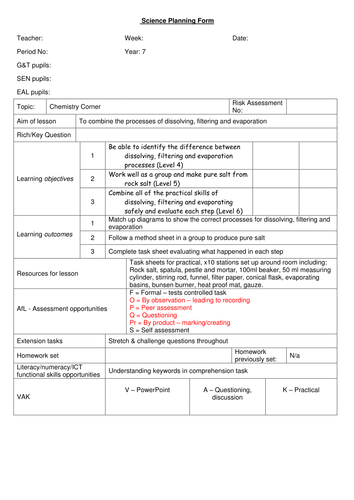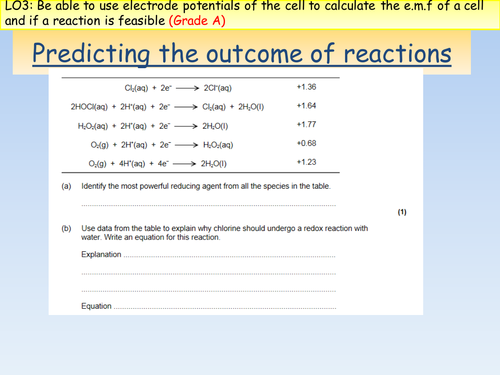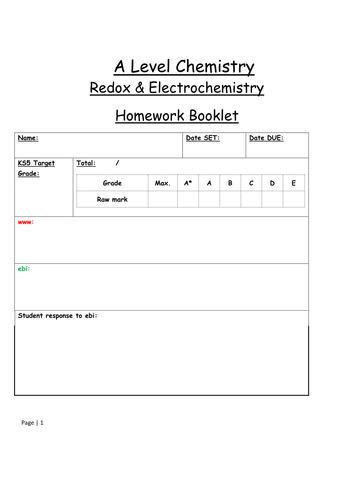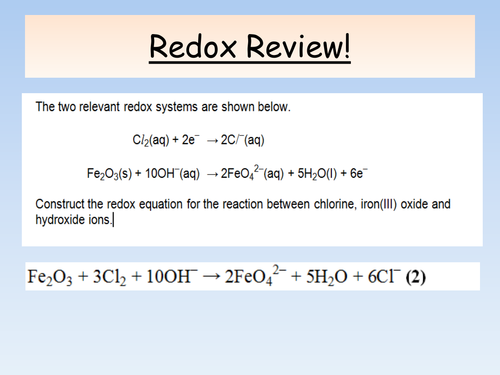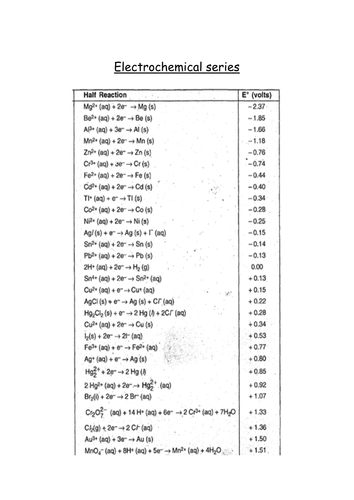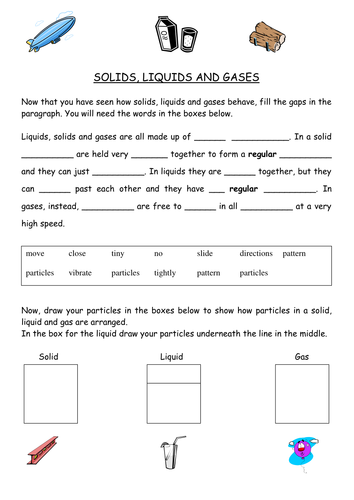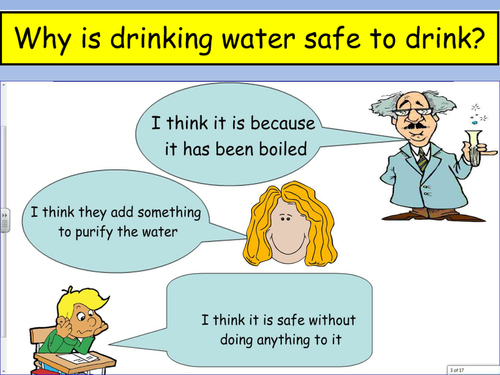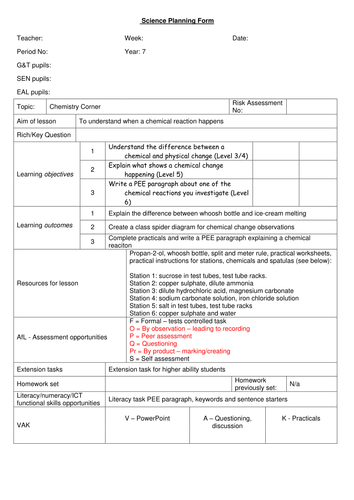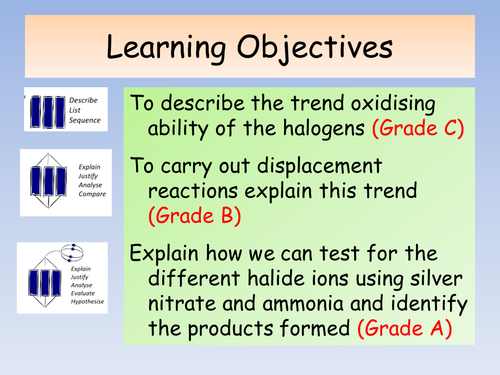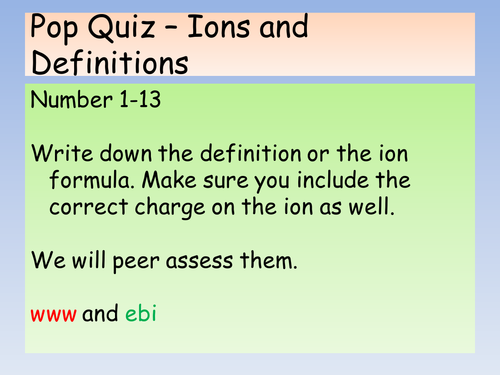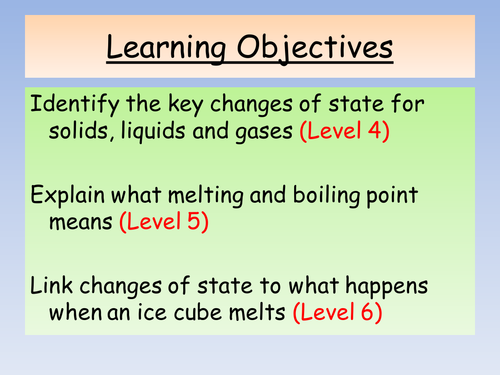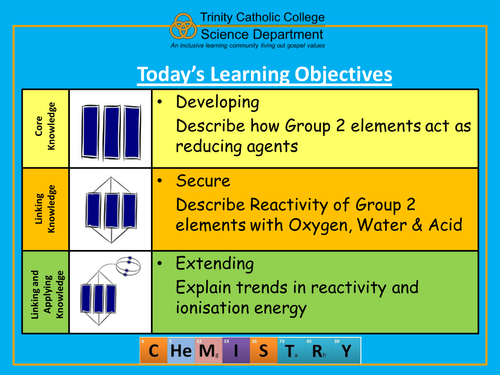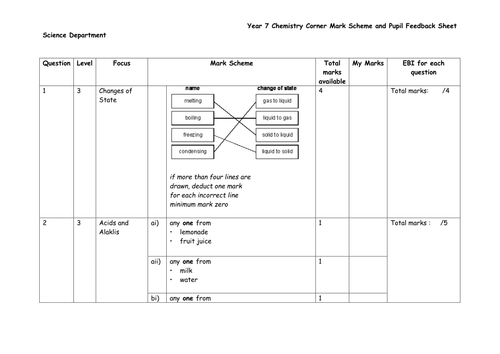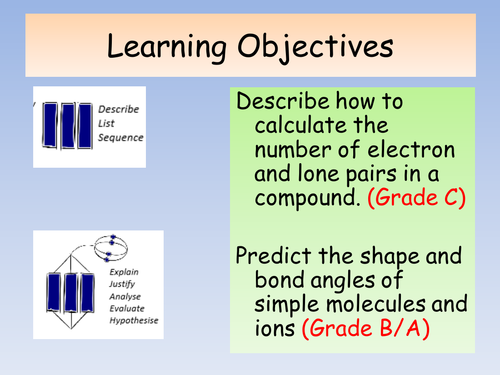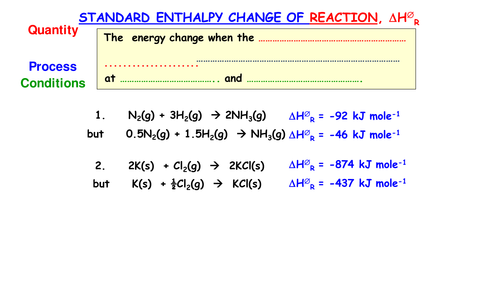
50Uploads
22k+Views
8k+Downloads
All resources

New AQA A level Chemistry Specification - Carboxylic Acids & Esters Lesson
This powerpoint would cover easily 2 lessons worth of content which covers:
IUPAC rules for naming carboxylic acids and esters.
Reactions of carboxylic acids
Forming esters from carboxylic acids and alcohols
Acid & Base Hydrolysis of esters
Mini practical instructions to make test tube esters.
This powerpoint is following the new A Level AQA Specification.

Chemistry Corner KS3 Year 7 Topic - Evaporation
This is the eleventh lesson in a topic I made called Chemistry Corner for KS3 Year 7.
This lesson includes a powerpoint on identifying dissolving, filtering and evaporation techniques from diagrams, what happens in evaporation and then a final group practical. This is a rock salt challenge so students are assessed on their group practical skills as well as their answers to the evaporation questions.
This scheme of work was made when KS3 Levels were used, so you may need to amend the levels according to your own assessment criteria used for KS3.

New AQA A Level Chemistry Lesson Fuel Cells
This lesson follows the new AQA A Level Chemistry specification 3.1.11.2
The lesson covers:
Recap on predicting if a reaction is feasible based on emf values
Exam question on predicting if a reaction is feasible
Examples of reversible and non reversible reactions and writing overall equation and calculating overall emf values.
Comparing advantages and disadvantages of reversible and non reversible fuel cells
Hydrogen oxygen fuel cell, youtube clips, how it works and equations
Hydrogen oxygen fuel cell diagram can be printed to A3 and annotated.
Advantages and disadvantages of hydrogen oxygen fuel cell

New AQA A Level Chemistry Electrochemistry Assessment booklet
This assessment booklet follows the new AQA A Level Chemistry specification 3.1.11
This can be used as either a homework booklet to accompany the topic or set as an end of topic assessment booklet. I used it as a homework booklet and it comes with a front cover sheet with room for www and ebi comments and mark scheme.
Extra exam questions have also been uploaded for this topic as well.

New AQA A Level Chemistry - Redox and Introduction to Electrochemical Cells
This lesson follows the new AQA A Level Specification Electrode Potentials and Cells 3.1.11.1
The lesson content covers:
Electrochemical cells and the role of the salt bridge
Daniell Cell Practical sheet (can be used as required practical 8)
Large cell diagram can be printed onto A3 and labels added
How to calculate electrode potentials
How to draw conventional representations of cells

New AQA A Level Chemistry Electrochemical Series and Standard Hydrogen Electrode
This lesson follows the new A Level AQA Specification 3.1.11.1 on Standard Hydrogen Electrode and Electrochemical Series
The lesson covers:
The role of the SHE
How changing conditions can affect electrode potentials
Electrochemical series and trends
Predicting if a reaction is feasible based on electrode potentials

Chemistry Corner Topic Year 7 - Solids, liquids and Gases lesson
This is the first lesson (maybe two lessons) in a topic I made called Chemistry Corner for Year 7 Chemistry.
The lesson includes ideas about the differences between solids, liquids and gases using a Venn diagram (which I would suggest enlarge to A3 and laminate along with the cards for future use), materials circus practical, properties of solids liquids and gases as well as an introduction to changes of state.
This scheme of work was made when Levels were used in KS3 so this may need to be amended for your own assessment criteria at KS3.

New AQA A Level Chemistry Lesspon - Fats & Oils
This powerpoint and practical sheet covers two lessons worth of content. The powerpoint covers:
How an ester bond forms a fat and oil.
Melting point of fats and oils and how they can be used to make soap.
How Biodiesel is formed and why it isn’t 100% carbon neutral.
Practical instructions to make soap using caster oil and sodium hydroxide (as well as an extra practical making detergent)
This powerpoint has been made following the new AQA A Level Chemistry specification.

OCR A Level Chemistry A New Spec (from Sept 2015) - Disproportionation and uses of chlorine lesson
This is the third lesson in the Halogens topic 3.1.3 in the OCR Specification.
The powerpoint covers what disproportionation means, reactions of chlorine in water and the ethical uses of chlorine in water. There is an exam question and mark scheme to assess learning but there is also a literacy based task with articles from Greenpeace and WHO to compare the ethical uses of chlorine in water.

Chemistry Corner KS3 Year 7 Topic - Simple Chemical Reactions
This is the fourth and fifth lesson in a topic I made called Chemistry Corner for KS3 Year 7.
This lesson includes a powerpoint on identifying factors that suggest a reaction has happened, differences between physical and chemical reactions, a practical activity circus investigating x6 reactions and a literacy task explaining one of the practicals in the circus.
This scheme of work was made when KS3 Levels were used, so you may need to amend the levels according to your own assessment criteria used for KS3.

OCR A Level Chemistry A New Spec (from Sept 2015) - Halide ion test lesson
This is the second lesson in the Halogens topic 3.1.3 in the OCR Specification.
The powerpoint covers the displacement reaction trends, oxidising ability recap exam question and a practical sheet which covers halide ion test with silver nitrate, dilute and conc ammonia.
The lesson also includes a student practical worksheet as well as a teacher/technician worksheet.

New AQA A Level Chemistry lesson - Acyl Chlorides
This lesson introduces the key ideas of Acyl Chlorides and will cover one lesson's worth of content. The powerpoint covers:
IUPAC rules for naming acyl chlorides
The 4 different reaction processes that acyl chlorides undergo.
The products and reactants needed for the 4 different acyl chloride reactions
The reaction mechanism for Acyl Chlorides is not covered in this single lesson powerpoint but another resource. This lesson is based on the New AQA A Level Chemistry specification.

New AQA A Level Chemistry Homework Booklet - Esters, Acid Chlorides and Acid Anhydrides
This homework booklet can be handed out at the start of the Carboxylic Acid and Derivatives section ( 3.3.9) of the New AQA A Level Chemistry Specification.
The mark scheme for the homework booklet is included as well. The homework booklet includes various exam questions both multiple choice and longer mark answer questions which cover the specification number above as well as the assessed practicals 10a and 10b.

OCR A Level Chemistry A New Spec (from Sept 2015) - The mole and Avogadro's constant lesson
This is the first lesson in the second topic The Amount of Substance in Module 2 - Foundations in Chemistry.
The powerpoint covers Avogadro's constant, the mole, molar mass and re-arranging the molar mass equation.
The activity is a good task to get students to understand what a mole is in terms of the number of atoms in your signature. The worksheets help introduce standard form and sig fig if needed to practice Maths skills as well as practicing re-arranging the molar mass equation.

Chemistry Corner KS3 Year 7 Topic - Changes of State lesson
This is the second lesson in a topic I made called Chemistry Corner for KS3 Year 7.
This lesson includes a powerpoint on changes of state (I always purchase some dry ice to demonstrate sublimation in class), properties of solids liquids and gases as well as melting and boiling points. There are also differentiated activity sheets and an extension task on icebergs.
This scheme of work was made when KS3 Levels were used, so you may need to amend the levels according to your own assessment criteria used for KS3.

OCR A Level Chemistry A New Spec (from Sept 2015) - Group 2 lesson
This is a lesson covering Group 2 elements, 3.1.2 in the OCR specification.
The powerpoint includes physical and chemical trends of group 2 metals. There is also a practical sheet which covers reactions of group 2 oxides, hydroxides and thermal decomposition of group 2 carbonates.

Chemistry Corner KS3 Year 7 Topic - End of Topic Test & Progress Planner
This is the end of topic assessment for the Chemistry Corner scheme of work.
There is also a front cover sheet using teacher and student assessment boxes for www and ebi. I have also included the progress planner to show the overall structure of the topic that students can stick into their books.
There is also a mark scheme and raw mark to level converter, however this scheme of work was made when KS3 Levels were used, so you may need to amend the levels according to your own assessment criteria used for KS3.

OCR A Level Chemistry A New Spec (from Sept 2015) - Shapes of molecules lesson
This is lesson 4 in the Electrons, bonding and structure topic in Module 2 - Foundations in Chemistry.
The powerpoint covers bonding pairs vs lone pairs repulsion, drawing simple shapes and a rule list for helping determine how many LP and BP and therefore what shape is produced. It also goes onto multiple bonds. I encourage the use of molymod kits for this lesson too, which helps with the 3D aspect of bonding.

Chemistry Corner KS3 Year 7 Topic - Neutralisation Reactions
This is the eighth lesson in a topic I made called Chemistry Corner for KS3 Year 7.
This lesson includes a powerpoint on introducing neutralisation reactions using a rainbow fizz demonstration, general word equations, students doing their own mini neutralisation reaction, neutralisation problems such as nettle stings etc.
This scheme of work was made when KS3 Levels were used, so you may need to amend the levels according to your own assessment criteria used for KS3.

New AQA A Level Chemistry Thermodynamics Lesson 1
This lesson is used as an initial recap on the Year 12 content on Energetics before starting the Thermodynamics topic fully from the new AQA A Level Chemistry topic 3.1.8
The powerpoint includes a variety of different energetics questions from Year 12 which can be distributed around the room as a circus of self assessment questions. Answers and mark schemes are included for each question, definition etc. The questions cover Enthalpy of formation, combustion and reaction, Calorimetry questions, Average bond enthalpies and Hess Cycles for formation and combustion.
Also included is a simple worksheet on exothermic and endothermic reactions which can be used as part of the circus as well.
At the end of the lesson students can highlight calculation areas they need to review from Year 12 from Energetics prior to starting the Thermodynamics topic. Also included is a list of the required definitions needed to know for the Thermodynamics topic which can be handed to students ready for pop quiz definition tests throughout the topic.


